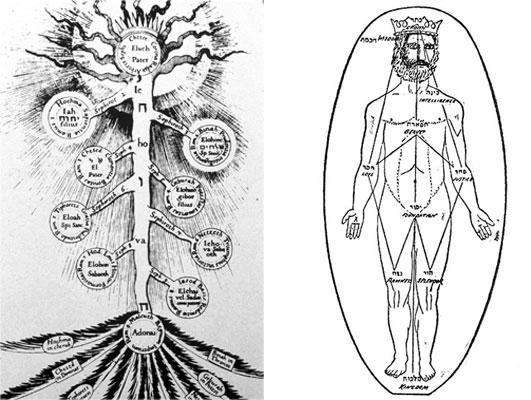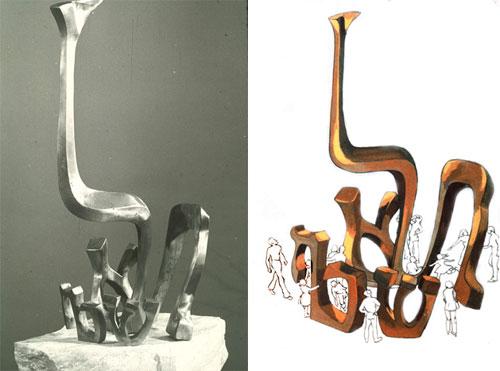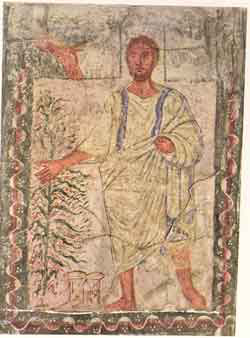For many of us, written language is as much a part of our reality as air—we hardly notice it, although it is constantly around us, influencing us consciously and unconsciously.
But the development of our writing system, the alphabet, was a long, complex process that is still evolving and essentially shapes the way we think and communicate. Our interest in the process has two foci: 1) the role of the alphabet in Creation and creativity within Jewish tradition and 2) the letters of the alphabet in art, especially but not only in response to the Torah's image prohibition.
The most ancient antecedents of writing are the famous Paleolithic cave paintings discovered in France and Spain in the 19th century. Although we still do not know the exact purpose of these paintings, it is clear that the concept of symbolization is already at work - the drawing of a horse somehow represents the horse itself.
The next stage in the development of writing is the pictogram - a stylized, rather than naturalistic depiction of an object, for example * as a sign for the Sun. Pictograms were developed by the Sumerians and their heirs, the Babylonians, into cuneiform script, in which each sign represented a syllable. In the land of Canaan, pictograms became single consonants, which became the basis of the Hebrew, Greek and Latin alphabets.

Note in particular the graphic similarity as well as the changes between the various alephs, the vavs, the mems, the ayins.
Like the alpha as the brightest star in a constellation, like the alpha and omega signifying ultimate beginnings and ends, so the aleph is the source of the heightened devotion of Jewish mysticism to the Hebrew alphabet, not for the sake of calligraphic acrobatics, but to create a symbol set by which we can see, hear, and quantify a personal connection with God.
Jewish mysticism has much in common with the mysticisms of other religions, but is distinguished by the importance it places on the written and spoken word of God as found in Torah. As Gershom Scholem points out, "that the word of God made itself heard through the medium of human language, acoustically and linguistically, is one of the most important legacies bequeathed by Judaism to the religions of the world" ("The Name of God and the Linguistic Theory of the Kabbalah", Diogenes 79 (1972) 60).
For Jewish mysticism the whole purpose of language is to convey God's word. The Talmudic sage known as Resh Lakish expressed this idea, linking Creation with Revelation through a midrash on the naming of the days in Genesis 1, where they are called simply Day 1, Day 2 until "Day 6":
For Resh Lakish said: Why is it written, And there was evening
and there was morning, the sixth day; What is the purpose of the
additional 'the'? This teaches that the Holy One, blessed be He,
made Creation conditional, saying 'If Israel accepts the Torah, you
shall thrive; but if not, I will return you to emptiness and
formlessness.' Shabbat 88a
The sixth day of Genesis 1 is midrashically connected to the sixth day of the month of Sivan, Shavuot, the day of the giving of Torah, thus identifying Creation with Revelation.
Rabbi Mendel Torum of Rymanov (d. 1814) was concerned with what we actually heard on Mount Sinai. For him, revelation was both an acoustic and a linguistic challenge. What could God possibly sound like? He concluded that Israel heard only the first letter of the first word of the first commandment, namely, the aleph of the word Anokhi, "I am." Even a beginning student in Hebrew would be instantly perplexed, since aleph is a silent letter. Scholem explains what Mendel Torum meant: that the aleph may be said to denote the source of all articulate sound, the "potential sound of the divine larynx, as it were, about to speak." Imagine hearing only the aleph, the latent possibility of all sound. In this way Rabbi Mendel transformed the revelation at Sinai into a mystical revelation "pregnant with infinite meaning but without specific meaning."
The aleph is the appropriate climax of a tale that relates how God came to use the letters of the Torah to create the world. The letters personified vie in turn for the first position in Creation. Each one presents herself as the embodiment of a particular quality that is essential for Creation, beginning with the last letter of the alphabet, the tav, which stands for Torah. The Holy One counters each positive quality with a negative quality; thus tav is the X that marks the doomed man. When the letters finally count down to bet, which stands for bracha 'blessing', there is no possible negative. So the Torah begins with bet, bereshit.
In the beginning (bereshit) God created the heavens and the earth
The modest and silent aleph, the last letter in the countdown, is mollified with second place: aleph is chosen to begin the Ten Commandments as Anokhi, "I am." Thus the aleph, apparently the understudy, becomes the star of revelation.
The tale, then, is an expression of the critical nature of every component of the Torah (including even the spaces between its letters), since the Torah is God's plan for the world. The letters represent the basic units of the Torah, the atoms of the world and meaning and therefore it is critical that the plan begin positively, with blessing.
Scholem further explains the obvious, which we probably never thought of: that vowels enable us to pronounce words. The vowel is the breath that connects the consonants. It is like the rest, the pause between notes in music that enables us to hear the music. This breath, this air, says Scholem, is clearly the breath of God (And the wind, spirit, of God hovered over the face of the deep, Genesis 1:2). Ah, so God plays hide and seek in the vowels! To clinch the argument we are reminded that God's official name YHWH or EHYH (the Tetragram) is composed only of breath letters (vowels), an unpronounceable sequence of exhaled breath. Those four letters in Hebrew—yod, heh, vav, aleph—were originally consonants that worked over time as vowels centuries before the Tiberian system of dots and dashes came into use in the 9th century of our era.

Sound wave – language as connection between Man and God
This picture, originally published horizontally, is intended to illustrate the phenomenon of sound waves, through which our speech is conveyed to others. But vertically it can also be understood as a metaphor for prayer being heard. The sound waves follow the opening of the larynx, where the invisible aleph initiates sound.
A. Mystical character of Hebrew letters

Cordovero's aleph is a non-iconic picture of God, who cannot be pictured. The head, torso, hands and feet of the aleph are inscribed with the names of the sephirot, which are the characteristics of God's personality. Since God is One and All, then the aleph, which is No. 1 and first, is God's perfect portrait.
The sephirot are also a way of visualizing the connection between God and Man, the basic mystery of the kabbalistic world – how can there be a connection between the wholly spiritual and the mundane material? The sephirotic network is a picture of the gradual process of the descent from the spiritual to the material. In the pictures below, the sephirot are inscribed as limbs of a tree (on the left) and on the right, as limbs of the human body.

As Mendel Torum was concerned with what we heard on Sinai, R. Phineas asks what did we see on Mount Sinai? An image first found in the Palestinian Talmud (Shekalim 25b) reads:
R. Phineas in the name of R. Simeon b. Levi said, The Torah that
the Holy One, blessed be He, gave Moses was given to him as white
fire inscribed with black fire: fire mixed with fire, carved out of fire
and given into fire, as it is written, From his right hand eternal fire
(Deuteronomy 33:2)

A striking visualization of "black fire on white fire" is Ben Shahn's graphic entitled The Alphabet of Creation. White fire is light, the presence of God. Black fire is darkness, the necessary background that frames dynamic shapes of light. This phenomenon has been translated into alphabet symbolism as follows: The Torah scribe sits before the vast white parchment. Entrusted with the sacred task of copying God's word he draws black letters onto the white expanse. Suddenly the white formless surface begins to take shape around the black letters. Parts of God's presence, the white fire, becomes visible thanks to the black fire of the letters. The bottom line: God (the white fire) needs us (the human endeavor, the black fire) so that some aspect of the Divine can be apprehended by humanity. Looking carefully at Ben Shahn's Alphabet of Creation, as looking intently at a page of Torah, we can also focus on the mystery of the background, the larger context.

M. Ardon, Creation Series: Aleph, 1970
The first thing that engages the viewer in Mordecai Ardon's lithograph is the large aleph on the left. On closer observation, there is a lacy fabric made of letters behind the aleph. The eye is further drawn to the right, to a super-dense red point emanating from within a whirling propeller, often identified as a perpetual motion machine. We may also see this point as the אין סוף, the ultimate beginning, the seed of the Big Bang. Thus, Divine energy is churning out the fabric of letters from which the big aleph emerges—potential to actual, visionary to mundane, chaos to order. This process of Creation is not only a one-time event. In the traditional morning liturgy, it is a daily miracle:
"The One who in His goodness renews the act of Creation each day."

Michele Zackheim, The Tent of Meeting (detail)
Above is part of a larger work called The Tent of Meeting, conceived by Michele Zackheim during her pilgrimage to Jebel Musa = Mt. Sinai. The Tent recalls the biblical Tent of Meeting, where "whoever sought the Lord would go .... And the Lord would speak to Moses face to face, as one man speaks to another" (Exod. 33:7, 11). Incorporating Jewish, Christian, and Islamic imagery, The Tent of Meeting expresses the hope that all who trace their origins to Abraham may see and understand in a new way.
One of Zackheim's panel deals with the giving of the Torah on Mt. Sinai. Moses and the tablets are dwarfed by the awesome mountains of Sinai. Hovering over him is the Divine Presence, represented as the pillar of cloud in the form of an aleph. Thus the voiceless first letter of the first word of the First Commandment is given visual articulation. Through her sophisticated use of hi-tech xerography, Zackheim combines two age-old characteristics of Jewish art-narrative and symbol.
Pictorially, the aleph is composed of an upper yod and a lower yod, connected by a diagonal vav. The upper yod can be seen as representing God, since it is the first letter of the Tetragram. The lower yod can be understood as the human being, created in the image. The vav (meaning 'hook', 'and') can be read as the way in which we connect.

In Mark Podwal's Torah pointer, which in Hebrew is called a yad 'hand,' (related to the letter yod, that began as a pictograph of the hand) the finger at its top becomes the vav in the Divine Name. Thus, the yad operates as an axis mundi, a world axis, connecting us with God. Similarly, Ted, a student of Hebrew calligraphy, focuses on the yod in God's name as the means of making his own personal connection.

Ted Virts, Yods
Ted writes about his yods:
How tight my hand becomes trying to grasp the simple stroke. When
I relax, the image comes easier. How tight I become in trying to grasp
God. Would that I could relax and let the light come to me.
Each yod is different yet recognizable. God may be the same, but
each of us sees differently. Or perhaps God is different to each of us
so that we know God from the place where we are able to know.
Even when I am not satisfied, others may see my intent. God may be
recognized in my mistakes. God may be recognized in my successes.
Writing is an act of an individual; meaning is an act of the
community. Without meaning, there is no writing; without writing,
there is no meaning.

Andy Herron-Sweet, Aleph, 1986
Andy, a divinity student, expresses a personal theology through the aleph:
The idea behind the two yods [that make up the aleph] is that, when the larger one is in the upper right, I feel very small in the face of a huge God. God is so huge, in fact, that God extends to the walls of the creation and encompasses all that is. The print may be turned upside down, and then I am the large encompassing body, in which God is a small piece. God is within me.
After I had cut the block, I realized there was a strong resemblance between the large yod and a wave and the small yod and a drop of water. This is quite appropriate. I see myself as being a drop in the "waters" of creation, the waters of life. A song I know has the chorus: "We are drops of water in a mighty ocean, we are sons and daughters of one life." Alternately, human bodies are something like 98 percent water, so God can be a drop in the water of my being, a drop indistinguishable from all the other drops.
B. Letters in nature

Franz, aleph in tree roots
The alphabet has become so much a part of our world that we begin to see it in nature, a human construct. For example, camera in hand, Franz turned to the hills "with the intention of finding a form that by my action would be consecrated as a sacred image." Significantly, the image alone could not be sacred, without the interaction, the process of the seeker.
This photograph is my aleph. Roots are a fine material for the aleph because they connect with the earth, with the inside, and also lead to the tree, which aspires to heaven. Here, roots are a mystical symbol. They are the axis mundi, leading up to God and even down to the underworld.
These roots show strength, power, and naturalness. Yet they move so slowly and their lines are unsure; they are blind: they must grope toward God. This comes close to my own relationship to God. Like a root, I am bound to the earth, blind, twisted. Yet it may be said I too am part of the axis mundi, the Tree of Life. If there is a Godhead I know that I aspire to it. I think if I can become as a root to the Tree I will be fulfilled.
The above works by students of theology and the arts emerge from the larger context of Hebrew calligraphy. The examples below are especially creative uses of the alphabet

We are charmed in the Hamilton Siddur by the whimsical zoomorphs playing within the letters of the text from the Passover Haggadah regarding "signs and wonders."

More abstract, although still figurative, are the micrographic fish adorning the center of the carpet page from a 15th century Yemenite Bible manuscript. The micrography spells out the text of Psalm 119, which is a lengthy hymn of praise to God employing an acrostic pattern, which encourages alphabet play. The figures, however, bear no known relationship to the text. The tiny letters have become purely decorative pointillistic dots. Paradoxically, micrography transforms words into images
C. Back to objects
Our journey with the alphabet began with real objects that became picture symbols, pictographs, signs, hieroglyphs and finally letters. But then, as we have seen, the letters stimulated artists' and thinkers' minds to transform them into literary and graphic creations. Thus, we come full circle and produce objects out of letters.

Holocaust survivor, artist Gizel Berman created a memorial to the six million for her adopted community in Seattle using the Hebrew letters of the phrase "you shall not forget" (לא תשכח), in which the lamed is especially evocative: the chimneys of the Auschwitz, an upraised arm of rage, etc. In the original design (on the left) the monumental proportions create an environment that the viewer can enter, be engulfed by the flaming letters so that the point is not to read the letters, but to experience them.

J. Kremer, Braille Genesis, Zelig Segal, Let there be light,
1986 2003
On a different level of abstraction, the development of the Braille alphabet in the 1820's transformed the two-dimensional letters into a three-dimensional code to enable the blind to read all letters and numbers by feeling relief forms in combinations of six dots. On the left, above, the first verse of Genesis is written in English, Hebrew (written from left to right) and Braille. Israeli artist Zelig Segal has taken the low relief of Braille and made it into a free standing sculpture, so that the "blind viewer" can read the sculpture by feeling the top surface of the cylinders that spell out יהי אור 'let there be light'.
For additional images on this subject see TALI Visual Midrash



